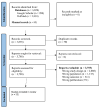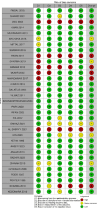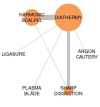The effectiveness of different flap-raising techniques for mastectomy in reducing the rate of complications: a network meta-analysis
- PMID: 39716134
- PMCID: PMC11665085
- DOI: 10.1186/s12893-024-02723-6
The effectiveness of different flap-raising techniques for mastectomy in reducing the rate of complications: a network meta-analysis
Abstract
Background: Seroma has been associated with some energy devices used in raising flaps during modified radical mastectomy. Perhaps, its occurrence might be reduced by determining the most effective technique for raising the flap. Hence, the wide array of energy devices available for mastectomy warrants a network meta-analysis for comparison to determine the most suitable for rseducing complications.
Methods: Searches were conducted on Google Scholar and PubMed for randomized controlled trials that compared the various energy devices (argon-cautery, diathermy, plasma blade, LigaSure, and harmonic scalpel) to traditional scalpel/scissors in mastectomy procedures. This review was registered with a PROSPERO number: CRD42023456510. The primary outcome was seroma formation, while the secondary outcomes included flap necrosis, drain effluent, and blood loss.
Results: Thirty-three studies were used for this network meta-analysis. Using sharp dissections (scissors or scalpel) for raising flaps in mastectomy reduced seroma formation [Odds ratio (OR): 0.375 (Credible interval (CrI): 0.244, 0.575)], Argon cautery decreased blood loss [Mean difference (MD): -304 (CrI: -698, 90.5)] but harmonic scalpel reduced the rate of flap necrosis [OR: 0.379 (CrI: 0.177, 0.791)] and the volume of drain effluent [MD: -383 (CrI: -704, -62.9)].
Conclusion: Using scissors or scalpels for mastectomy was associated with a reduction in the rate of seroma. In addition, the volume of drain effluent was reduced using a Harmonic scalpel compared to other energy devices. Aside from a reduction in flap necrosis rate, blood loss, and the volume of drain effluent; energy devices for raising flaps in mastectomy were not entirely superior to scalpels or scissors.
Keywords: Blood loss; Flap-raising; Mastectomy; Seroma.
© 2024. The Author(s).
Conflict of interest statement
Declarations. Ethics approval and consent to participate: Not applicable. Consent for publication: Not applicable. Competing interests: The authors declare no competing interests.
Figures








Similar articles
-
Comparing the effectiveness of full-vacuum and half-vacuum drainage in reducing seroma after modified radical mastectomy: a meta-analysis.Ann R Coll Surg Engl. 2025 Mar;107(3):167-173. doi: 10.1308/rcsann.2024.0034. Epub 2024 May 9. Ann R Coll Surg Engl. 2025. PMID: 38721944 Free PMC article.
-
Prophylactic mastectomy for the prevention of breast cancer.Cochrane Database Syst Rev. 2004 Oct 18;(4):CD002748. doi: 10.1002/14651858.CD002748.pub2. Cochrane Database Syst Rev. 2004. Update in: Cochrane Database Syst Rev. 2010 Nov 10;(11):CD002748. doi: 10.1002/14651858.CD002748.pub3. PMID: 15495033 Updated.
-
Ultrasonic dissection versus electrocautery in mastectomy for breast cancer - a meta-analysis.Eur J Surg Oncol. 2012 Oct;38(10):897-901. doi: 10.1016/j.ejso.2012.05.006. Epub 2012 Jun 14. Eur J Surg Oncol. 2012. PMID: 22704049
-
Interventions for treating people with symptoms of bladder pain syndrome: a network meta-analysis.Cochrane Database Syst Rev. 2020 Jul 30;7(7):CD013325. doi: 10.1002/14651858.CD013325.pub2. Cochrane Database Syst Rev. 2020. PMID: 32734597 Free PMC article.
-
Comparison of Flap Fixation to Its Bed and Conventional Wound Closure with Drainage in Preventing Seroma Formation Following Mastectomy for Breast Cancer: Systematic Review and Meta-analysis.Aesthetic Plast Surg. 2022 Jun;46(3):1180-1188. doi: 10.1007/s00266-022-02814-w. Epub 2022 Feb 28. Aesthetic Plast Surg. 2022. PMID: 35226117
References
-
- Pogson CJ, Adwani A, Ebbs SR. Seroma following breast cancer surgery. Eur J Surg Oncol J Eur Soc Surg Oncol Br Assoc Surg Oncol. 2003;29:711–7. 10.1016/s0748-7983(03)00096-9. - PubMed
-
- Porter KA, O’Connor S, Rimm E, Lopez M. Electrocautery as a factor in seroma formation following mastectomy. Am J Surg. 1998;176:8–11. 10.1016/s0002-9610(98)00093-2. - PubMed
-
- Yilmaz KB, Özaslan C, Gürer A, et al. Scalpel versus electrocautery dissections: the effect on wound complications and pro-inflammatory cytokine levels in wound fluid. Turk J Med Sci. 2008;38:111–6.
Publication types
MeSH terms
LinkOut - more resources
Full Text Sources
Medical

